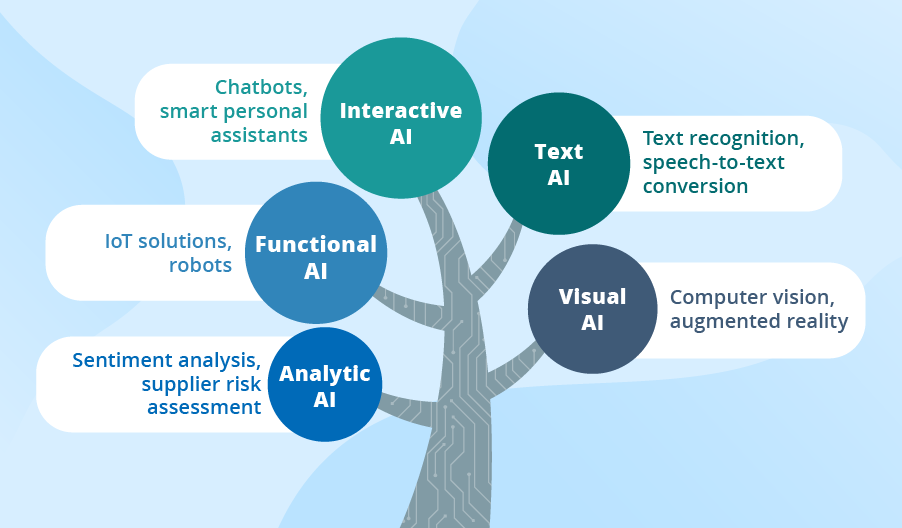5 Types of AI to Propel Your Business
Similar to a constellation where you can spot different stars, artificial intelligence (AI) can be brought down into different types. To help you decide what AI type will shine brightest and contribute to your business’ stellar performance, our data science consultants will define each. However, let’s first dispel the clouds to have a clear look at AI as a whole.
AI defined
Artificial intelligence enables a computer system to be trained and apply the gained knowledge to new inputs. This ability rests upon math and algorithms and is applicable only to the tasks that the system has been trained to perform.
To visualize the AI concept clearer, you may think of a chatbot whose task is to help restaurant visitors to book a table. By nature, this chatbot is a computer program that is trained on tons of booking-a-table questions and relevant answers. That’s how it learns of a typical conversation flow on the topic. After the training, the chatbot can dialogue with customers. However, if a customer deviates from the main topic of booking a table and asks for food recommendations, the chatbot in question is of little help as it is not trained to perform this task.
Types of artificial intelligence

To help you decide how exactly AI business ideas can be put into practical use, we offer our classification based on our 35 years of experience in data science. For each AI type, we’ll give a brief explanation, name the most prominent business use cases, as well as share real-life examples from our artificial intelligence consulting practice.
Analytic AI
Powered by machine learning (including its most advanced deep learning techniques), analytic AI scans tons of data for dependencies and patterns to ultimately produce recommendations or provide a business with insights, thus contributing to data-driven decision-making.
Sentiment analysis and supplier risk assessment are just a few examples of analytic AI in action. If you’d like to get a complete picture of how such a solution works, our experts have summarized the insights gained from their experience with two of the use cases – inventory optimization and demand forecasting.
Functional AI
Functional AI is very similar to analytic AI – it also scans huge amounts of data and searches for patterns and dependencies in it. However, instead of giving recommendations, functional AI takes actions. For instance, being the part of the IoT cloud, it can spot a machine-breakdown pattern in the sensor data received from a certain machine, and trigger a command to turn this machine off. Another example: robots that Amazon uses to bring the shelves with the goods to the pickers, thus speeding up the picking process.
Interactive AI
This type of AI allows businesses to automate communication without compromising on interactivity. To envisage this type of AI, think of chatbots and smart personal assistants whose abilities can vary from answering pre-built questions to understanding the conversation context.
Interactive AI can serve another purpose – improving a company’s internal processes. For example, one of our AI software development projects was dedicated to creating a chatbot to facilitate the corporate process of vacation booking.
Text AI
Businesses that use text AI can enjoy text recognition, speech-to-text conversion, machine translation, and content generation capabilities. Even if a company is not Google or Amazon, or any other giant company that provides text AI as a service, it can still take advantage of this AI type. For example, the company can use text AI to power an internal corporate knowledge base.
Contrary to a traditional knowledge base that rests upon a search by keywords, an AI-powered one can find the document containing the most relevant answer even if the document doesn’t have full keywords. This is possible thanks to semantic search and natural language processing, which allow AI to build semantic maps and recognize synonyms to understand the context of the user’s question.
Visual AI
With visual AI, businesses can identify, recognize, classify, and sort objects or convert images and videos into insights. A computer system that helps an insurer to estimate damage based on damaged car photos or a machine that grades apples based on their color and size are the examples of visual AI. This type of AI covers computer vision or augmented reality fields.
To get a real feel of the value that visual AI can bring, you can read in more detail about a face recognition solution that we developed to help a retailer enhance and personalize their customer service; or about an application for automated inspections that allowed a manufacturer to immediately control the quality of the produced details.
In the finale
AI has become a trend that cannot be disregarded: hardly any report or survey doesn’t mention its growing importance. Gartner names AI a top priority for CIOs. Accenture Technology Vision 2019 Report cites that 89% of businesses either have already adopted or are experimenting with AI. And PWC 2019 AI Predictions Survey of 1,000 executives reveals that they expect the following value from AI investments: increased revenue and profits (48%), better customer experience (46%) and improved decision-making (40%). However, to take advantage of AI, companies have to overcome some obstacles. For example, a survey by McKinsey&Company names top 3 barriers: the lack of a clear strategy for AI (43%), the lack of the talent with appropriate skills (42%) and functional silos that constrain end-to-end AI solutions (30%).
And what about your business? We have shown the multifaceted nature of AI for you to find your way to get value from it. You can opt for any of 5 AI types – analytic, interactive, text, visual, and functional – or wisely combine several ones. Read on to see how to develop AI software and estimate approximate cost ranges.
